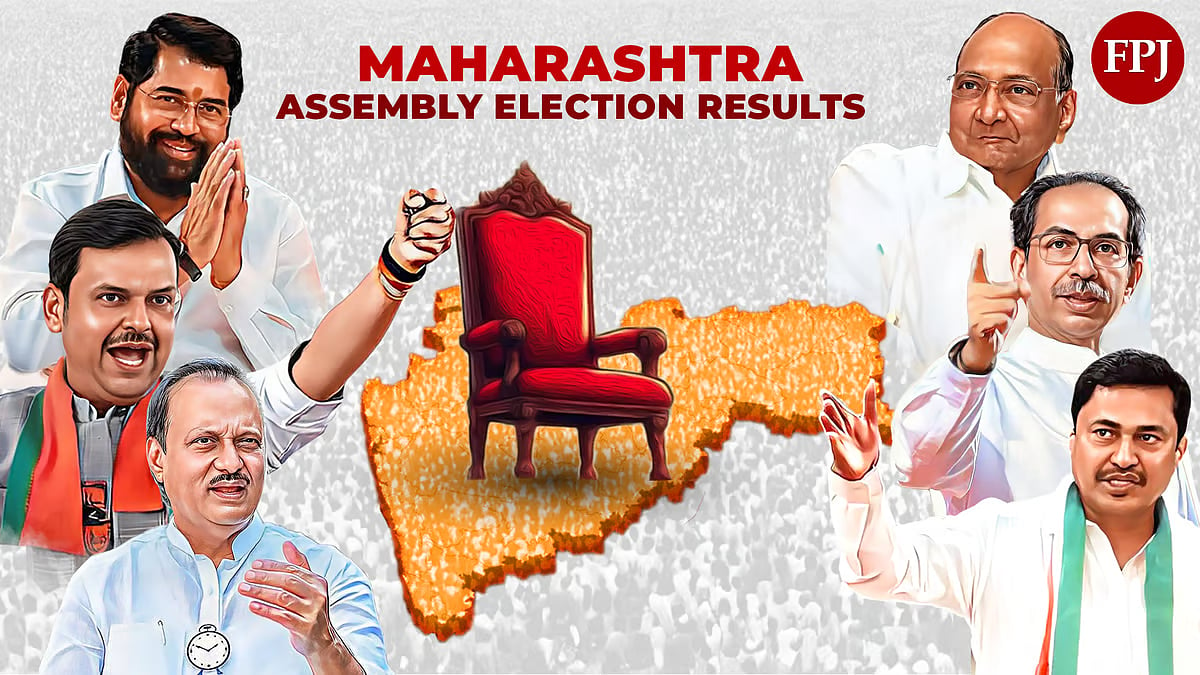Known for his ability to craft spine-tingling tales that delve into the darkest corners of the human mind, author K. Hari Kumar has become a prominent voice in the horror genre. Whether it's supernatural forces, psychological terror, or real-world fears, his stories leave a lasting impact. Kumar is back with another bone-chilling horror book, Dakini, which releases on October 17 and is published by HarperCollins. Inspired by real-life witch-hunting that’s still prevalent in rural India, Kumar’s Dakini blends folklore, mythology, and supernatural elements.
In an interaction with The Free Press Journal, Kumar talks about the inspiration behind Dakini, what it takes to create truly unforgettable horror, and plans ahead.
Excerpts from the interview:
What is Dakini about and what can readers expect from it?
Dakini is an immersive Indo-gothic epic horror novel that weaves together elements of folklore, mythology, and supernatural terror. At its core, it’s the story of a journalist from Mumbai who becomes deeply entangled in the eerie folklore of an Adivasi village. Her initial mission is to save a Dalit widow, accused of witchcraft, from execution, but what she uncovers is a far more sinister reality rooted in ancient beliefs and dark forces. Expect a blend of spine-chilling horror, Indian mysticism, and a haunting exploration of the thin line between myth and reality. Readers will be drawn into a world where superstition and ancient rituals collide with the contemporary, raising unsettling questions about fear, power, and the unknown.
What inspired you to write this story?
The inspiration for Dakini came from reading about the witch-hunt cases that still occur in parts of India, where it is often women who are targeted and accused of witchcraft. The fact that such practices persist today is both disturbing and thought-provoking. Around the same time, I experienced a personal loss that left me grappling with grief. The intersection of these two ideas—how society hunts down women in the name of superstition and how we cope with personal tragedy—eventually merged into the concept of Dakini. It became a way for me to explore how myths, fear, and grief intersect in the darkest corners of our lives, blurring the lines between superstition and reality.
Are there any real-life events or places that inspired Dakini?
Yes, Dakini is inspired by real-life incidents, particularly the witch-hunt cases that tragically continue to occur in various parts of India. While the story itself is entirely fictional, it draws heavily from these unsettling realities. To create an authentic narrative, I conducted extensive research into tribal folklore, the dynamics of life in tribal villages, and the phenomenon of fear psychosis and its impact on the human psyche. Additionally, my research for Daiva played a crucial role in helping me understand totemism, which I used as a foundation to build the world within Dakini. This combination of research allowed me to create a rich, nuanced environment that reflects the complexities of belief systems and cultural practices, ensuring that the story resonates with both authenticity and depth.
How did you balance fear and discomfort while writing Dakini? Is there anything that’s ‘too much’ for horror?
I have written eight books till date, out of which six are horror. Out of four screenplays, three are horror. Having experience in writing horror has given me a certain comfort level with fear and discomfort, and I believe it actually helped me find closure during the creative process. In my view, there is no such thing as “too much” horror as long as it serves the narrative and adds depth to the story. Horror can be a powerful tool for exploring complex emotions and societal issues.
Are there any challenges you faced while writing Dakini or your other works?
Yes, I faced several challenges while writing Dakini. I was going through a personal loss, which made it difficult to navigate the emotional landscape required for crafting a horror narrative. Additionally, I was juggling my film career with the on-ground research needed for my previous book, Daiva. This combination of responsibilities extended the writing process for Dakini to over two years. I found myself rewriting the manuscript at least a dozen times to capture the right tone and depth, ensuring that the story resonated authentically with readers. It was a demanding journey, but one that ultimately enriched the narrative.
Do you have any rituals or habits to get into the right headspace for writing horror? What do you do to come out of that headspace?
To get into the right headspace for writing horror, I often read similar books or watch films in the genre. This helps immerse my mind in the atmosphere and themes I want to explore. Additionally, I like to listen to appropriate music while writing, as it enhances the mood and fuels my creativity. To transition out of those intense writing sessions, I sometimes watch movies from the opposite genre. This shift helps clear my mind and allows me to return to a more balanced state. Engaging in light activities, such as going for a walk or reading something unrelated, also aids in that transition. Temple visits and meditation also helps.
You mentioned in one of your social media posts that Dakini is your last horror novel. Why is that?
Horror writing can take a significant toll on mental health, and Dakini, with its personal elements, has been particularly intense for me. Each time I sat down to write a chapter, it felt like I was losing a piece of my mind. I believe it’s better for me to focus on writing non-fiction and mytho-fiction for a while—genres that are not too far removed from horror but offer a different creative outlet. I’m also happy to contribute to Indian literature through important works like Daiva, which allow me to explore different themes while maintaining a connection to my roots.
Why do you think people are so drawn to the horror genre despite it being scary or unsettling?
People are often drawn to the horror genre because it offers an escape from the mundane aspects of everyday life. Horror, along with fantasy and science fiction, allows readers and viewers to explore the unknown and confront fears in a safe environment. It taps into our primal emotions, providing a thrilling experience that can be both unsettling and exhilarating.
What’s the most difficult part about writing horror?
The most challenging aspect of writing horror lies in effectively conveying the sense of horror itself, as it can vary significantly from person to person. What terrifies me might not elicit the same reaction in someone else. Additionally, Indian authors have to avoid clichés and ensure they are not just slapping Indian names on Western supernatural entities. A chudail is not a vampire, and vice versa. It’s crucial to honor the rich Indian folklore and create something that resonates authentically with readers.
How has your approach to writing horror evolved since you first started?
When I first started writing books twelve years ago, my focus was primarily on finishing the book—just getting to “The End” as quickly as possible. It felt like a race. Now, my approach has shifted significantly; I write with the intention of crafting a narrative that I genuinely want to read and rewrite. This is my tip to all aspiring authors out there—Write not just to finish, but to craft a story that captivates you and your readers—rewriting is where the real magic happens.
What initially drew you to the horror genre?
What initially drew me to the horror genre were my dadi’s folktales about rakshasas, pretas, dakinis, and yakshis. They were also because of the stories my mother would from Chandamama and Balarama.
What next can readers expect from you, since you are moving away from horror?
Readers can expect non-fiction that explores Indian folklore and regional mythology, serving as a spiritual successor to Daiva and linked to Tulu Nadu and Kerala. I’m also venturing into mytho-fiction, inspired by our rich Puranic traditions. These genres are closely related to horror, as much of what we consider horror today has evolved from folklore and mythology. This allows me to delve into the cultural narratives that shape our understanding of the supernatural while contributing to the discourse in Indian writing and literature.
Quick takes
Favourite horror writer(s) and book(s)?
Ira Levin and Stephen King; Rosemary’s Baby and Pet Sematary.
Scariest horror book that messed up your mind?
I think Rosemary’s Baby messed with my mind. The fact that your neighbours can be part of a Satanic cult and do weird things to you really creeped me out.
Favourite horror trope?
The gothic manor at the edge of a forest with large trees and restless souls.
Which horror villain would you have a conversation with? Why?
Dracula, because I want to understand him in a way only Francis Ford Coppola did.
What's your biggest fear?
Enclosed spaces.
Why are people drawn to horror?
“Horror entertainment activates the fight-or-flight response, leading to a surge in adrenaline, endorphins, and dopamine. Certain personality traits, such as sensation-seeking, predispose individuals to enjoy this excitement. Sensation-seekers are characterized by their stimulating experiences. They face potential stressors as challenges to be overcome rather than threats that might scare them. They recognize that this experience is in a safe and controlled environment which often makes them gravitate toward different types of horror films for more similar experiences,” says Sumanpreet Kaur Khanna, Counselling Psychologist and Founder, Mind Unwind, Mumbai.













